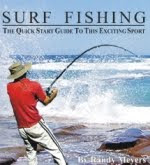There are a lot of choices a surf angler can choose from when selecting a surf fishing rod for a particular purpose. It helps if you already have some idea of the type of fishing you plan to do.
Generally speaking the length of the surf rod
 will most likely be between 8' and 12'. If you don't require casting distance and plan on using it to fish in the breakers then an 8' rod should suffice.
will most likely be between 8' and 12'. If you don't require casting distance and plan on using it to fish in the breakers then an 8' rod should suffice.For greater casting distance most surf anglers will settle on something between 10' and 12'.
Now I'd like to address some of the others aspects of selecting a surf rod. Fishing rods are designed around several characteristics. I won't bore you with all the technical explanations but I will cover the basics.
The basic design characteristics used are:
- Action - how much the rod bends when put under pressure
- Taper - defines the thickness of the rod & the blank
- Power - defines the strength of the rod in terms of lifting power
- Responsiveness - the ability of the entire rod to flex, the whip factor
An experienced angler will likely fish in a variety of ways and thus have several rods for different purposes. On the other hand someone just starting out would probably be perfectly happy with medium heavy, 10' - 12' surf rod. Later with more experience the new angler would add more gear to suit other needs.
In either case before selecting a surf fishing rod consider:
- How strong the rod needs to be.
- The casting distance for the length of the rod.
- The whip factor to get the casting distance needed.
Click this link if you want to learn about surf fishing rods. You can find out more about it there.


